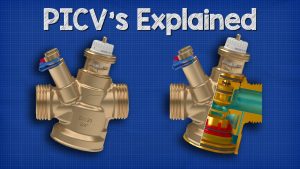In recent years, the hydraulic and thermal imbalances in some northern residential areas are very serious. The resistance loss of the proximal users is small, and the water supply is short-circuited from the proximal end to the thermal station, resulting in the room temperature of the proximal users and the low room temperature of the distal users, resulting in a high rate of complaints. Despite the use of a pressure balance valve and flow balance valve in the design, the phenomenon of low room temperature in the proximal part and the distal part remains unsolved.
Description of Thermal Balancing Valve
The Inta range of thermal balancing valves is for use in hot water circulating systems. The valve provides a thermal balance on the system by regulating the flow within it depending on the desired temperature setting. When this setting is reached the valve closes down to its minimum position which allows for other draw-off points to be supplied with sufficient hot water.
- Helps to improve the efficiency of DHW systems
- Thermostatic self-balancing control automatically responds to changes in system temperature and flow requirements
- Reduces heat loss through the lower circulation of hot water
- Helps to keep temperature evenly distributed and reduces dead-legs
- Reduces the consequences of oversized circulation pumps
Thermal balancing valves can effectively solve the above problems, and have an excellent effect in some residential areas. Its working principle is to automatically open or close the opening of the valve by measuring the hot water temperature flowing through the valve body and utilizing the characteristics of thermal expansion and contraction of the thermosensitive material, thereby automatically adjusting the water flow. When the water temperature is high, the flow through the valve is small or even closed. When the water temperature is low, the water flow is large, even the valve is completely opened. This change changes with the change in temperature.
The thermal balancing valve is installed in the backwater pipeline of the heating system, and the water flow is automatically adjusted according to the backwater temperature to avoid the direct short circuit of high-temperature water to the backwater pipeline, so as to ensure that the hot water in the water pipeline can reach the far end, make full use of the heat energy and save energy. And the handle on the thermodynamic balance valve can adjust and set the temperature of the backwater at any time. The temperature data of backwater can be obtained by measuring the temperature of the outer wall of the backwater pipe with an infrared thermometer, which is convenient for adjusting the temperature of a backwater.
In the past, the single-pipe series design was used in most household pipelines. The application of a self-powered thermal balancing valve is limited. It is mostly used to solve the problem of a heat balance between buildings. Moreover, due to the lack of extensive understanding of the performance of the thermo-balancing valve, it is often used as a remedy after the problem of unbalanced heating in the heating system has arisen. Therefore, the manufacturer only produces large caliber heat balance valves of more than 40 mm, which are mostly used in thermoelectric, pharmaceutical, petrochemical, and other industries.
At present, the heating system in-house pipes are parallel connected by two pipes. In the heating system design, various balancing valves are mostly installed in the water supply pipes. If a thermal balancing valve is installed in the backwater pipeline in the design, the inlet flow can be controlled by controlling the temperature and flow rate of the backwater and replacing the pressure (flow) balance valve, the effect can be multiplied by half the effort.
Features of Thermal Balancing Valve
Thermal Balancing Valves are thermostatic circuit control valves that automatically control the temperature within a circulating hot water system to ensure a balanced water temperature throughout
the system.
Available in 15mm and 20mm configurations, the valves are adjustable from 40°C to 65°C, and are factory set at 58°C.
- Easy temperature adjustment between 40°C and 65°C
- Tamper-proof cap
- Built-in disinfection function to protect against Legionella
- Dry-fit push-in thermometer
- Supplied with insulation
- Meets Australian Standard for potable water supply
- Individually tested and calibrated
- Every valve is tested to ensure higher quality and performance












